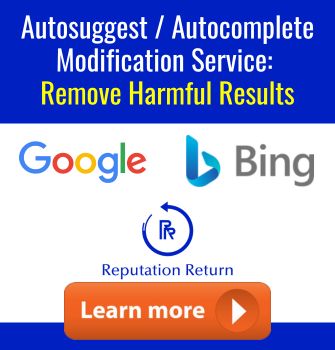In today’s digital age, regaining trust after a reputation crisis is more critical than ever. Brand trust rebuilding is not just a challenge; it’s a necessity for businesses aiming to restore their credibility and customer loyalty. The loss of customer confidence can have long-lasting effects, often driving clients straight to competitors.
Research from Deloitte reveals that 88% of executives consider reputation risk as a top strategic concern. A case in point is the 2013 Target data breach, where initial underestimation of the issue led to significant credibility loss. Transparent communication is vital, as 70% of consumers are more likely to trust companies that openly acknowledge their mistakes.
At ReputationReturn.com, our mission is to guide businesses through the complex process of restoring their brand trust. We offer a free, private consultation to discuss your specific needs and create tailored strategies to help you rebuild your reputation and regain customer trust.
Key Takeaways
- Transparent communication is crucial for rebuilding trust after a crisis.
- Loss of customer confidence can lead to long-term negative impacts.
- 70% of consumers trust companies that acknowledge mistakes openly.
- Expert guidance is essential for effective reputation rebuilding.
Understanding the Crisis: Why Rebuilding Trust Matters
When a reputation crisis strikes, the bond between a company and its consumers is severely tested. Relationships built over years can crumble if not addressed promptly and transparently.
Data shows that when consumer trust is lost, up to 40% of Americans will not return, illustrating the severe impact of reputation damage. This breakdown can lead to significant revenue loss and long-term challenges in regaining marketing ground.
Impact of Reputation Loss on Customer Loyalty
The immediate effects of a reputation crisis often manifest in declining sales and customer loyalty. Over time, this can evolve into a broader loss of market share, as consumers turn to competitors. Rebuilding loyalty is not just about recovering lost customers but also about reestablishing a connection that fosters long-term engagement.
Real-World Examples and Lessons Learned
Consider the case of Volkswagen, which faced a drastic decline in customer trust due to the 2015 emissions scandal. The company’s failure to address the issue promptly led to hefty fines and a damaged reputation. In contrast, KFC’s transparent response to a chicken shortage in 2018 helped sustain customer loyalty, demonstrating the effectiveness of prompt communication.
For companies facing a reputation crisis, understanding the root causes of the damage is crucial. This involves taking clear steps to identify the issues and addressing them openly. Research shows that transparent communication can mitigate the risk of losing customers and revenue. Additionally, expert guidance can provide tailored strategies to navigate the crisis effectively.
Rebuilding customer loyalty is a strategic necessity. It requires a dual focus on regaining lost marketing ground and reestablishing customer connections. By addressing the root causes of reputation damage and implementing clear, actionable plans, companies can work towards restoring their relationship with consumers and ensuring long-term success.
Exploring Credibility and Authenticity in the Digital Era
In today’s fast-paced digital world, credibility and authenticity are the cornerstones of a strong reputation. Brand trust, as defined by research from Northwestern University, is the firm belief that a company will consistently deliver on its promises and maintain an authentic communication style. This trust is built on transparency, integrity, and a consistent way of conducting business.
Defining Brand Trust and Its Core Elements
At its core, brand trust is about reliability and sincerity. It’s about aligning your service delivery with the expectations you set. When a company keeps its promises, it sends a powerful message about its commitment to integrity. This alignment is crucial for building long-term relationships with customers and stakeholders.
The Role of Transparent Communication and Integrity
| Component | Importance |
|---|---|
| Fulfilling Promises | Builds reliability and credibility |
| Transparent Media Communication | Enhances trust through openness |
| Consistent Service Delivery | Demonstrates commitment to quality |
| Employee Commitment | Reflects brand values in action |
Transparent communication through media and consistent service delivery are essential for maintaining trust. Employees also play a vital role by upholding brand values, even during crises. A well-defined strategy and decisive action can mitigate negative perceptions and reinforce a company’s commitment to authenticity.
Maintaining a consistent and genuine way of doing business is vital in the digital age. By focusing on transparency and integrity, companies can build strong, lasting trust with their audiences. Contact ReputationReturn.com for a free, private consultation to explore how we can help you navigate these challenges and strengthen your reputation.
Techniques for brand trust rebuilding
Rebuilding trust after a crisis requires strategic approaches that engage customers and demonstrate commitment. One effective method is leveraging social proof through user-generated content and testimonials. By showcasing real customer experiences, businesses can authentically rebuild their reputation. Partnering with influencers through content marketing can also expand reach and credibility, helping to regain customer confidence.
Leveraging Social Proof and User-Generated Content
Encouraging customers to share their positive experiences fosters authenticity. Testimonials and reviews act as powerful tools, providing social proof that your business is reliable and trustworthy. This approach not only rebuilds trust but also encourages others to engage with your brand.
Implementing Influencer and Content Marketing Strategies
Influencers can amplify your message to a broader audience. Content marketing strategies, such as blogs and videos, provide valuable information that resonates with customers, reinforcing your commitment to their needs and preferences.
Establishing Clear, Actionable Plans
A dedicated team implementing well-defined plans signals reliability. Real-world examples, like Maggi’s use of consistent messaging on social media, show how clear communication can improve sales and trust over time.
Every person’s effort and each campaign contributes to restoring trust. Consistent, genuine communication is critical, demonstrating long-term commitment to customers. Contact ReputationReturn.com for a tailored strategy to navigate your reputation crisis effectively.
Navigating a Reputation Crisis: Insights from Notable Case Studies
Learning from real-world examples is crucial for understanding how to manage and recover from a reputation crisis. These case studies provide valuable lessons on the importance of swift action, transparency, and strategic communication.
Maggi’s Comeback: Using Hashtags and Consistent Messaging
Maggi’s journey from crisis to recovery is a prime example of effective reputation management. When concerns about MSG led to a severe crisis, Maggi implemented bold strategies to regain consumer confidence.
- The campaign #WeMissYouToo resonated deeply with customers, showcasing empathy and a commitment to listening.
- Consistent messaging through TV commercials reinforced Maggi’s dedication to quality and safety.
- By sharing user stories and encouraging feedback, Maggi rebuilt trust and regained 60% of its market share.
These efforts highlight the power of digital tools and social media tactics in reversing negative perceptions. Maggi’s approach demonstrates that a well-executed plan can transform a crisis into an opportunity for growth.

Understanding these strategies can help businesses prepare for future challenges. To learn more about assessing your current reputation and creating a recovery plan, visit this resource.
Contact ReputationReturn.com for a free, private consultation to discuss your specific needs and develop a tailored strategy for navigating your reputation crisis effectively.
Building Consistency Across Channels for a Strong Brand Image
Consistency across all channels is the backbone of a strong brand image. In today’s competitive market, maintaining a unified visual identity and messaging is crucial for building and maintaining consumer trust. When a company presents a cohesive image, it sends a powerful message about reliability and professionalism.
Unified Visual Identity and Messaging
A strong brand image begins with a consistent visual identity. This includes everything from logos and color schemes to typography and imagery. When these elements are unified across all channels, they create a recognizable and trustworthy brand presence. For instance, Maggi’s successful comeback was largely due to their consistent messaging and visual identity, which helped regain consumer trust and market share.
The impact of consistent messaging cannot be overstated. It not only reinforces your brand’s values but also ensures that your audience receives a clear and cohesive communication. This consistency is particularly important in crowded digital channels, where businesses compete for attention. By maintaining a unified visual identity, companies can stand out and build a strong emotional connection with their audience.
The process of ensuring consistency requires careful planning and effort. Every channel, from social media to websites, must communicate the same brand personality. This involves regular monitoring and adjustments to maintain alignment. For example, discrepancies in brand presentation can confuse customers and harm their confidence. To avoid this, businesses should implement best practices for monitoring and controlling content across all digital channels.
Best practices include creating detailed brand guidelines, conducting regular audits, and training teams to understand the importance of consistency. By taking these steps, companies can ensure that their brand image remains strong and trustworthy across all platforms.
Contact ReputationReturn.com for a free and private consultation to discuss how we can help you build consistency across channels and strengthen your brand image.
Measuring Success and Evolving Your Trust-Building Strategy
Effectively measuring success and adapting your strategy are critical steps in maintaining and improving customer trust. By continuously assessing your efforts, you can identify areas for improvement and ensure long-term success.
Establishing Benchmarks and Tracking Metrics
To gauge the effectiveness of your trust-building efforts, set clear benchmarks and track key metrics. These may include customer retention rates, Net Promoter Scores (NPS), and social media engagement. Regularly monitoring these metrics allows you to assess progress and make data-driven decisions.
Using Digital Tools to Monitor and Improve Customer Experience
Digital tools play a vital role in monitoring customer experience in real time. Analytics platforms can provide insights into customer behavior and sentiment, helping you address issues promptly. For instance, resolving a single customer complaint quickly can lead to increased satisfaction and loyalty.
By interpreting insights from tracking data, you can refine your strategy to better meet customer expectations. This proactive approach ensures that your efforts align with market demands, fostering long-term success.
Meeting customer expectations through ongoing measurement is essential for sustained growth. A well-executed strategy, supported by continuous monitoring, helps build resilience and strengthens your position in the market.

Contact ReputationReturn.com for a free and private consultation to discuss your specific needs and develop a tailored strategy for navigating your reputation crisis effectively.
Conclusion
In today’s competitive landscape, maintaining a strong website presence is crucial for any marketer. Consistent, transparent communication is the cornerstone of any successful strategy, driving purchase decisions and ensuring long-term success. By implementing the expert strategies discussed—such as leveraging social proof, engaging with influencers, and establishing clear, actionable plans—businesses can navigate crises effectively and rebuild customer confidence.
The insights from real-world case studies, such as Maggi’s comeback and Volkswagen’s recovery, highlight the importance of swift action and transparent communication. These examples demonstrate that strategic approaches not only mitigate damage but also create opportunities for growth. Continuous measurement and adaptation of your strategy are essential for sustained success, ensuring that efforts align with customer expectations and market demands.
For businesses seeking expert guidance, ReputationReturn.com offers a free, private consultation to help you navigate your reputation crisis effectively. Remember, rebuilding trust is a journey that leads to sustained long-term achievement in website purchases and customer success. By adhering to proven strategies and embracing innovation, you can ensure a resilient and thriving future for your brand.
FAQ
How can a business regain customer trust after a reputation crisis?
Regaining trust involves transparent communication, addressing issues promptly, and demonstrating commitment to improvement. Consistent positive actions and empathy can rebuild trust over time.
Why is rebuilding trust crucial for customer loyalty?
Trust is the foundation of customer loyalty. Without it, businesses risk losing their customer base and facing long-term reputational damage.
Can you provide real-world examples of successful trust rebuilding?
Yes, companies like Maggi and Volkswagen have successfully regained trust through consistent messaging and transparency, demonstrating effective strategies in action.
How does transparent communication impact credibility?
Transparent communication fosters credibility by showing honesty and integrity, which are essential for maintaining trust and a positive reputation.
What role do social proof and user-generated content play in trust building?
Social proof and user-generated content build trust by showcasing real customer experiences, providing authentic evidence of a brand’s reliability and quality.
How can influencer marketing help in trust rebuilding?
Influencers can enhance trust by endorsing products, leveraging their credibility to reassure customers and promote the brand’s commitment to quality.
What strategies can ensure consistency across all marketing channels?
Unified messaging, consistent visuals, and regular audits across all channels help maintain a strong, cohesive brand image that builds trust.
How can a business measure the success of its trust-building efforts?
Success can be measured through metrics like customer retention rates, positive reviews, and increased engagement, indicating improved trust and loyalty.
What tools are effective for monitoring customer experience?
Tools like social media listeners and customer feedback platforms help monitor and improve customer experience, providing insights to enhance trust-building strategies.















